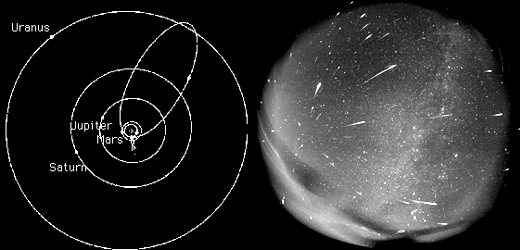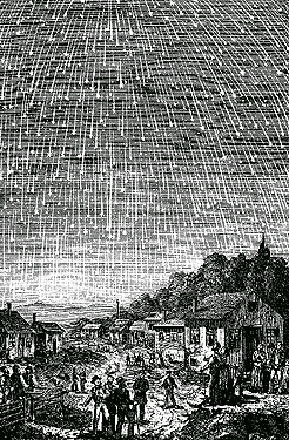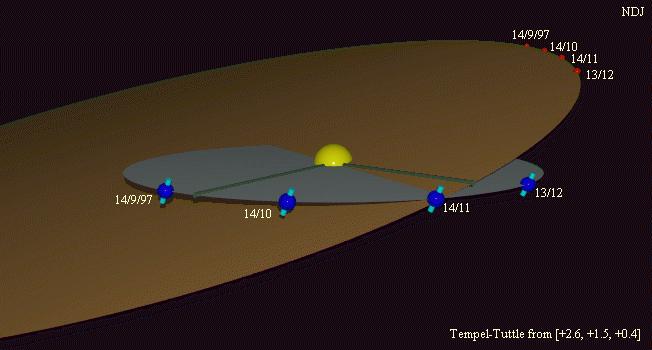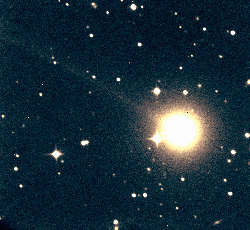

The annual Leonid meteor shower might bring some excitement in the early
morning
hours (2:00 am to just an hour before the sunrise) of coming
Tuesday (19/11/2002).
 Rates
of 50 meteors an hour is considered good, however this year, predictions (with
some marginal errors) of rates several thousands meteors per-hour are being
estimated for those lucky enough to be awake during those hours and of course
in the right region. The prediction is that Western
Europe and Americas may be more suitable for the high rate than the others.
Rates
of 50 meteors an hour is considered good, however this year, predictions (with
some marginal errors) of rates several thousands meteors per-hour are being
estimated for those lucky enough to be awake during those hours and of course
in the right region. The prediction is that Western
Europe and Americas may be more suitable for the high rate than the others.
The peak is expected to be between 3 am and 5:30 am for the Arabian Peninsula.
We may observe between 10 to 25 meteors per hour in our area provided we
choose a dark area away from man made light pollution. Make sure to start
observing 2 or 3 hours earlier so as not to miss a thing.
For more detailed information you may visit my homepage: users.kfupm.edu.sa/PHYS/alshukri
Or send an email to alshukri@kfupm.edu.sa.
Check out the following links for complete information, observing tips
and charts :
The Leonid MAC at
http://aio.arc.nasa.gov/~leonid/estimator.html
Leonids
Live - Live data from NASA : <http://leonid.arc.nasa.gov/live/newlive.html>
Armagh Observatory Leonid Page : <http://www.arm.ac.uk/leonid/index.html>
Leonid 2000 Photo Gallery : <http://www.spaceweather.com/meteors/gallery_18nov00.html>
Space.coms reports and photo tips : <http://www.space.com/scienceastronomy/astronomy/leonids_2001.html>
The following article which I wrote last year may give you more information about the LEONIDS:
Dr. Ali Mohammad Al-Shukri - Physics Department
A comet is a celestial body consists of frozen water, gasses, and dust. As it approaches the sun during its journey around it, the comet will be heated up and some of its outer part will be evaporated by the solar heat and radiation and a tail or more of gas and dust will be formed. Short period comets spend most of their time in the solar vicinity, which are constantly subjected to gravitational tidal forces of planets especially giant ones such as Jupiter and Saturn which may lead to their decay or disintegration and continual lose of their mass in a fast rate. The leftover debris continues to move in the same orbit, but due to solar wind and perturbations from the planets they will disperse in much wider area. Comets leave behind the evaporated dust particles during their close approach to the solar vicinity in the course of their journey around the sun.
Those debris move in the same orbit around the sun. Those particles will be scattered in a form a stream around the entire orbit.
In a course of a year as earth moves in its orbit around the sun, it crosses with orbits of many periodic comets. That passage causes the comets debris of dust and gas to enter the earth's upper atmosphere and at high speeds (typical speed ranges from 20 to 50 kilometers per second and it may be as high as 70 km/hr.). The outcome is streaks or trails of lights as a result of igniting and burning and vaporizing or exploding of those materials due to friction with the atmospheric constituent. The phenomenon is called a meteor shower if there are few to tens of those lines of light per hour. On the other hand if the number is in the range of hundreds to thousands per hour or more it is called a meteor storm. A single streak of light is called a shooting or falling star. Meteor showers are named for the constellation that is seen in the region where apparently those meteors are radiated from. It is similar to the case of driving at high speed in a rainy day where you notice as you look in front of you that rain streams are rushing toward you as if it is radiating from a point in the direction of motion. Of course this is not true, the rain is falling vertically down word, but the relative velocities create such phenomena. The Earth is regularly bombarded with material from outer space and a meteor that does not belong to an identified meteor shower, which may come from any direction and at any time, is called a sporadic meteor. An extremely bright meteor is called a fireball. A meteor that explodes along its track is called a bolide. The size and brightness of those streaks of light differ depending on the size, composition, and the speed of those particles (object ranges in size from rocks down to extremely tiny grains). Some may partially survive and fall on the ground as meteoroids. It is estimated that several millions of kilograms of materials are deposited on the earth surface each year.
 During
November 17-19 every about 33 years a meteor storm (several thousands to tens
of thousands streaks of lights per hour) is expected, assuming the debris
collective motion and spread are as predicted, as earth crosses the elongated
elliptical orbital plain of comet Temple-Tuttle while the comet is near the
crossing point either ahead or behind of it, where it sheds off some of its
outer dust cloud layer due to solar heat and wind. A much lower magnitude
shower (a few tens to a few hundreds meteors per hour) could be seen a year or
two earlier or later too. Also a yearly passage of earth near the crossing
point may rise to a very low magnitude shower (a few to tens of shooting stars
per hour) every year. The meteor shower associated with comet
Tempel-Tuttle is radiated from Leo (Lion)
constellation therefore it is called Leonid meteor shower or simply
Leonids.
During
November 17-19 every about 33 years a meteor storm (several thousands to tens
of thousands streaks of lights per hour) is expected, assuming the debris
collective motion and spread are as predicted, as earth crosses the elongated
elliptical orbital plain of comet Temple-Tuttle while the comet is near the
crossing point either ahead or behind of it, where it sheds off some of its
outer dust cloud layer due to solar heat and wind. A much lower magnitude
shower (a few tens to a few hundreds meteors per hour) could be seen a year or
two earlier or later too. Also a yearly passage of earth near the crossing
point may rise to a very low magnitude shower (a few to tens of shooting stars
per hour) every year. The meteor shower associated with comet
Tempel-Tuttle is radiated from Leo (Lion)
constellation therefore it is called Leonid meteor shower or simply
Leonids.
November 17 - 18 of 1999 and 2000 (and may be 2001) were expected to be good candidates dates for Leonid meteor storms. The closest approach between the earth and the center of the meteoroid stream is expected to reach 150 thousands kilometers. Lack of information about the amount of material added to the stream and the perturbation on it by recent passages of the comet through that region, the inconsistencies within the dust cloud surrounding the comet, and degree of the spread and dispersion of the debris in addition to effects of planetary perturbations and solar radiation pressure led scientists to develop several diverse theoretical models which put the rate of the shower or storm for 1999 between 100 to 10000 meteors per hour. This rate is called Zenithal Hourly Rate (ZHR) and it gives the hourly rate of the shower in a clear sky for the case of radiant is directly over head, at zenith and away from light pollution. Even though the predictions of peek rate and timing are most difficult, matching the theoretical models with past records of data of the maximum magnitude of the storms, the dates of the past perihelion (the closest approach to the sun) passages of the comet (it adds some additional material to the stream during each passage), and the knowledge of 1998 leonid activity profile, let scientists to put the estimated maximum ZHR to less than 2000 and may be closer to 1000, but definitely not less than 100. And the predicted peek time of the Leonid meteor storm is estimated to occur at 5 a.m. on 18 November 1999 according to Saudi Arabian time when earth begins to enter the dense region of the comet's debris (head on collision between the earth and the debris). During that moment, as earth crosses the orbit of Comet Tempel-Tuttle, Europe, Africa, and Western Asia including Middle East will be on the side of the earth that is in direct collision with those particles with the peak of the storm lasting few hours. During the year 2000 the Arabian Peninsula had an the advantage of being near the area that faced the incoming debris stream during the encounter period and that is not far away from the peak of maximum magnitude of the Leonids of an estimated ZHR between 600 and 800. Actually about 1000 meteors per hour were observed in north-western part of Saudi Arabia during that year. During this year the Arabian Peninsula does NOT have the advantage of being near the area that faces the incoming debris stream during the encounter period, but there is a chance to see a lower magnitude meteor shower of several tens of meteors per hour in our area (10 to 25 meteors per hour). Please note as mentioned above the diversity of conditions may force the show to go either way.
If you are interested, dress appropriately for the weather and just be prepared to choose a dark area away from all city lights and obstacles. Then start at about midnight (3:00 a.m. to 5:00 a.m. may be the best time) looking up towards the east in the area of sickle of the Leo (Lion) constellation (upper part of Leo, as it rises from the east, looks like an Arabic question mark or backwards English “question mark”). Leo rises at about 11:30 p.m. Try not to concentrate only on the small area of the radiant. A Leonid meteor starts at the sickle of the lion, but it may be visible to the naked eye as it moves away. Therefore, try to look in different directions, at least to keep your neck away from stress and strain. You may continue looking and counting those meteors to just before the sunrise time. Form time to time an isolated shooting star may appear anywhere in the sky; it is called a sporadic meteor. Another way to observe meteor showers is by using a simple multi-banded radio. Usually meteor showers re-enforce radio signals due to bouncing the signals off the meteors, therefore one of the ways to observe meteor activities is to tone to a far away station of a very weak signal and listen to any random re-enforcement of the signals.
Meteor showers take place in the higher atmosphere and present no danger except, of course if part of it is survived and hit the surface of the earth as a meteorite, but that is infrequent and hitting a particular location is very rare. Unfortunately, it is not the case for upper atmosphere and outer space. Therefore satellite operators are concerned that even small impacts could impair some of the 600 operational satellites orbiting the earth and may short-circuit their sensitive sensors. NASA, the U.S. Air Force, and the University of Western Ontario in London, Ontario and other organizations will coordinate a team that helps track changes in the shower that could be a storm. Meteor Storms may cause a potential threat and risk to NASA and U.S. Air Force spacecraft and satellites. A worldwide network of radar and optical observation sites were made available for monitoring the storm. In reducing the impact effect to the satellites, their solar panels (arrays) are aligned parallel to the incoming debris stream. In an effort to learn more about the leonids, NASA scientists will launch a balloon to record meteor images, sounds, and maybe able to collect some dust particles associated with the shower.
For more detailed information you may visit my homepage: users.kfupm.edu.sa/PHYS/alshukri
Or send an email to alshukri@kfupm.edu.sa.
Also you may visit the following sites for additional information about meteor showers: 1) The Leonid MAC at http://aio.arc.nasa.gov/~leonid/estimator.html 2) International Meteor Organization at http://www.imo.net/ 3) Jordanian Astronomical Society http://www.jas.org.jo
Kindly send me an email (alshukri@kfupm.edu.sa) or a fax (860-2293) regarding your observations including the following information for each observing period: Date and time, number of meteors observed, total time, location, and direction.
Your comments and suggestions are welcomed.
Dr. Ali Mohammad Al-Shukri, Assistant Professor, Physics Department, KFUPM,, Phone 860-3573 or 860-2255, Fax 860-2293, KFUPM Box # 378, Dhahran 31262, Saudi Arabia
LEONID METEOR SHOWER
Leonids
may shine despite glaring guesT (2002)
One of the most celebrated meteor showers will
peak next week over Europe and North America, sending hundreds or thousands of
fireballs streaking through the atmosphere.
Copied from:
![]()
For details visit: http://www.cnn.com/2002/TECH/space/11/13/leonids.meteors/index.html
Outcome of Nov 19, 2002: http://www.cnn.com/2002/TECH/space/11/19/leonids.meteors/index.html
Two of the best sites about Leonids 2002 are:
http://spacescience.com/headlines/y2000/ast21nov_1.htm
 ASTRONOMICAL SOCIETY OF AUSTRALIA
ASTRONOMICAL SOCIETY OF AUSTRALIA
 http://leonid.arc.nasa.gov/meteor.html
http://leonid.arc.nasa.gov/meteor.html
 http://science.nasa.gov/headlines/y2002/14nov_leonidtips.htm
http://science.nasa.gov/headlines/y2002/14nov_leonidtips.htm
Prof. Peter. Jenniskens, NASA
Sirko Molau (Germany)
John Walker
NASA (www-space.arc.nasa.gov/!leonid)
IMO (International meteor Organization) - www.imo..net
Dutch Meteor Society (DMS)
The Living Earth, Inc.
In a course of a year as earth moves in its orbit around the sun; it crosses with orbits of many periodic comets. That passage causes the comets debris of dust and gas to enter the earth's upper atmosphere and at high speeds (a typical speed ranges from 10 to 40 kilometers per second). The outcome is streaks or trails of lights as a result of vaporizing and burning of those materials due to friction with the atmospheric constituent. The phenomenon is called a meteor shower if there are few to tens of those lines of light per hour. On the other hand if the number is in the range of hundreds to thousands per hour or more it is called a meteor storm. A single streak of light is called a shooting or falling star. Meteor showers are named for the constellation that is seen in the region where those meteors are radiated from.
The Earth is regularly bombarded with material from space and a meteor that does not belong to an identified meteor shower is called a sporadic meteor. The size and brightness of those streaks of light differ depending on the size, composition, and the speed of those particles (a typical object ranges in size from rocks down to extremely tiny particles). Some may partially survive and fall on the ground as meteoroids. It is estimated that several millions of kilograms of materials are deposited on the earth surface each year.
During November 17-18 every about 33 years a meteor storm (several thousands to tens of thousands streaks of lights per hour) is expected as earth crosses the elongated elliptical orbital plain of comet Temple-Tuttle while the comet is near the crossing point either ahead or behind of it. A much lower magnitude shower (a few tens to a few hundreds meteors per hour) could be seen a year or two earlier or later too. Also a yearly passage of earth near the crossing point may rise to a very low magnitude shower (a few to tens of shooting stars per hour) every year. The meteor shower associated with comet Tempel-Tuttle is radiated from Leo (Lion) constellation therefore it is called Leonid meteor shower or simply Leonids.
November 18 of 1999 was a good candidate date for meteor storms in East Europe. Leonid meteor storm started at about 1 a.m. on 18 November 1999 according to Saudi Arabian time when earth begins to enter the dense region of the comet's debris. At that moment Eastern Europe was on the side of the earth that is in direct collision with those debris as it crosses the orbit and the peak of the storm only lasted for an hour. The Arabian Peninsula will be facing in the same direction as Europe at about 5:00 a.m. local time 18 November, and that is off the peak magnitude of the Leonids. But there was a chance to see a lower magnitude meteor storm or shower (ten or so meteors per hour) in our area. (If you are interested, just be prepared to choose a dark area. Then start at after midnight (3:00 a.m. to 4:00 a.m. may be the best time) looking up towards the east in the area of sickle of the Leo (Lion) constellation (upper part of Leo as it rises from the east). You may continue (if you have some spare time) to just before the sunrise time even though a shooting star may appear any where in the sky). You may visit my home page for more detailed information at (http://users.kfupm.edu.sa/PHYS/alshukri)
Physics
Department at KFUPM made seveeral arrangements for a get
together to watch the event and answer questions related to the event during the
passed years (1999 - 2001). The location was the roof of building 6 in
KFUPM. .
(<<)
Go Up
 (<<)UP
(<<)UP
(<<)

 Comet
55P/Tempel-Tuttle photo
Comet
55P/Tempel-Tuttle photo
(<<) GO UP